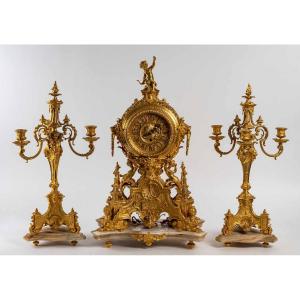Representing a faun and a love after the work of Clodion and Delarue
The two sculptures hold in their hands two cornucopias forming arms of lights in chiseled and gilded bronze with the attributes of the vine. French work 18880-1890
Dimensions: H: 90 cm / L: 32 cm: D: 28 cm
base: 20 cm / 20 cm - Lampshade = 40 cm / 40 cm / 28 cm
Bibliography
Clodion for the faun or the satyr Claude Michel, known as Clodion Sculptor (1738 - 1814)
Claude Michel, known as Clodion, is one of the most important European sculptors of the second half of the 18th century and the first years of the following century. Originally from Nancy, he came to settle in Paris relatively young and entered the workshop of his uncle, the sculptor Lambert-Sigismond Adam. Then after the death of the latter, he completed his training for a while with Jean-Baptiste Pigalle. Quickly, young Clodion demonstrated extraordinary talent. In 1759, he won the first prize for sculpture, then left for Rome three years later with a student certificate from the French Academy. His stay in Rome will be essential for the formation of his style which will assert itself and which will attract him some precious support, in particular the painter Natoire, and powerful sponsors, particularly the Empress Catherine II who will try in vain to bring him to Russia. In 1771, back in France, he acquired a great reputation for his groups of nymphs, bacchantes and satyrs, particularly sought after by collectors. At the end of 1773, he returned to Italy, charged by the King's Buildings Department with purchasing marble in Carrara. Subsequently, until the Revolution, he received numerous and important orders for the royal family and the great enthusiasts of the time. After the fall of the monarchy, he continued his work much more timidly, then died in Paris, rue de la Sorbonne, in March 1814.
And The Rue or Delarue Louis-Félix de (Paris 1730 - Paris 1777 Louis-Félix Delarue was born on October 19, 1730 in Paris and died on June 24, 1777. He was a French designer and sculptor. Younger brother of Philibert-Benoît de La Rue, he was a student of Lambert Sigisbert Adam. Winner of the prestigious Prix de Rome in 1750, in 1754 he obtained the necessary diploma to become a student of sculpture at the Academy of Rome. He was admitted to the Académie de Saint-Luc in 1760. He worked for the Sèvres porcelain factory. Two porcelain figurines made from Delarue's model are kept at the Victoria and Albert Museum in London.


















































 Le Magazine de PROANTIC
Le Magazine de PROANTIC TRÉSORS Magazine
TRÉSORS Magazine Rivista Artiquariato
Rivista Artiquariato